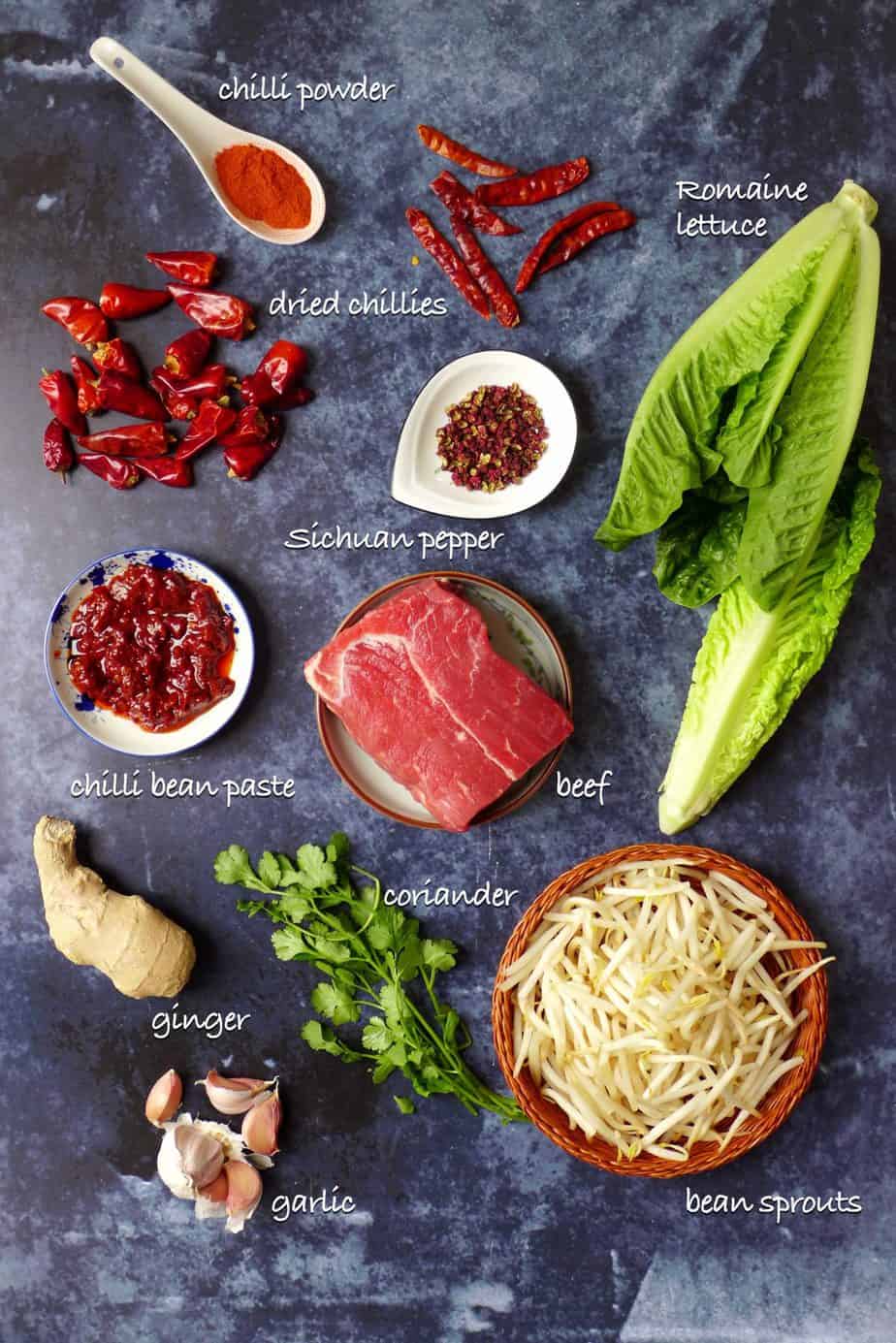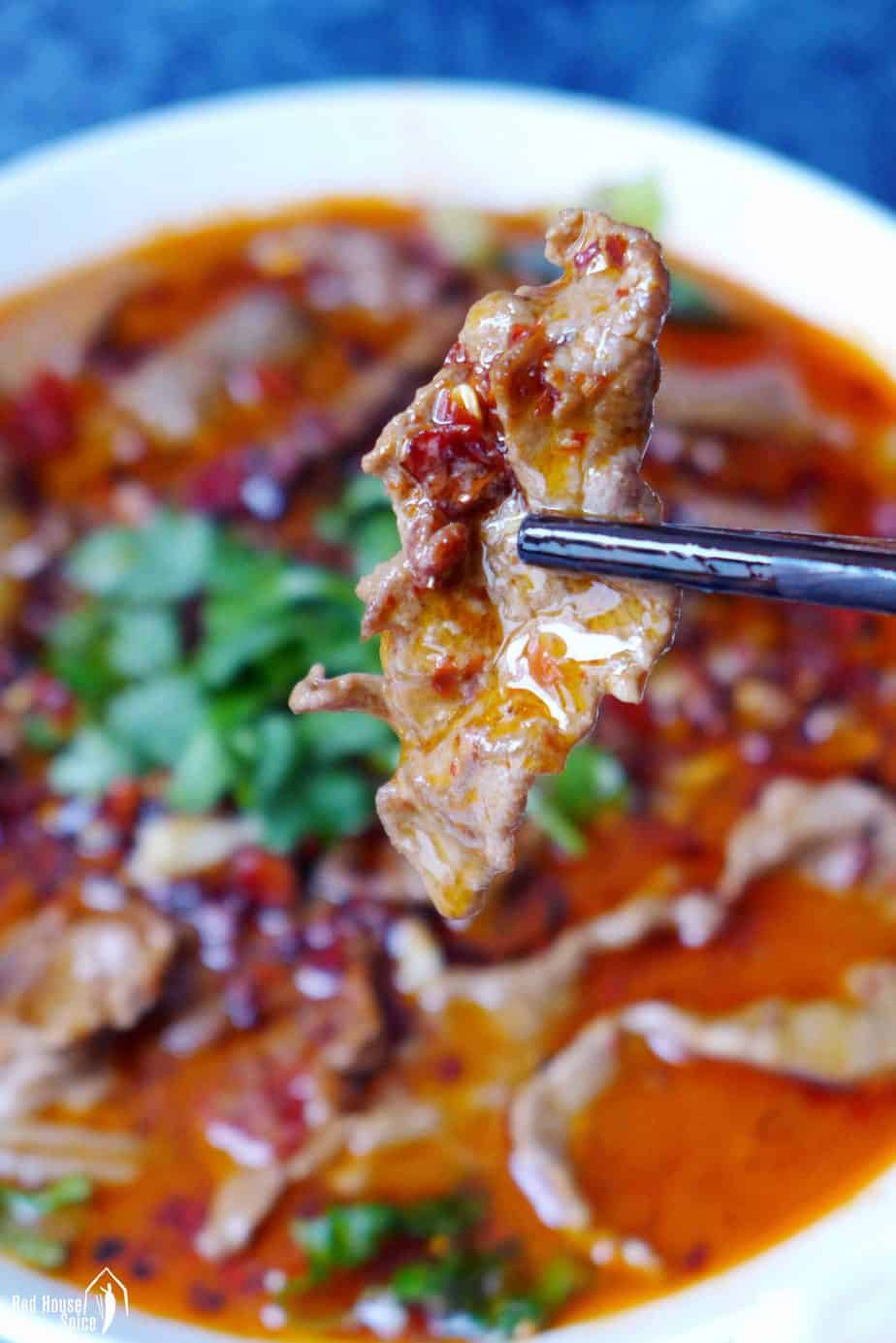Sliced Beef in Sichuan Chili Hot Sauce
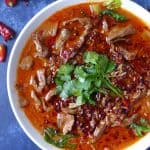
Delicious beefiness and crispy vegetables seasoned with generous amounts of spices, Sichuan boiled beef is super flavoursome!
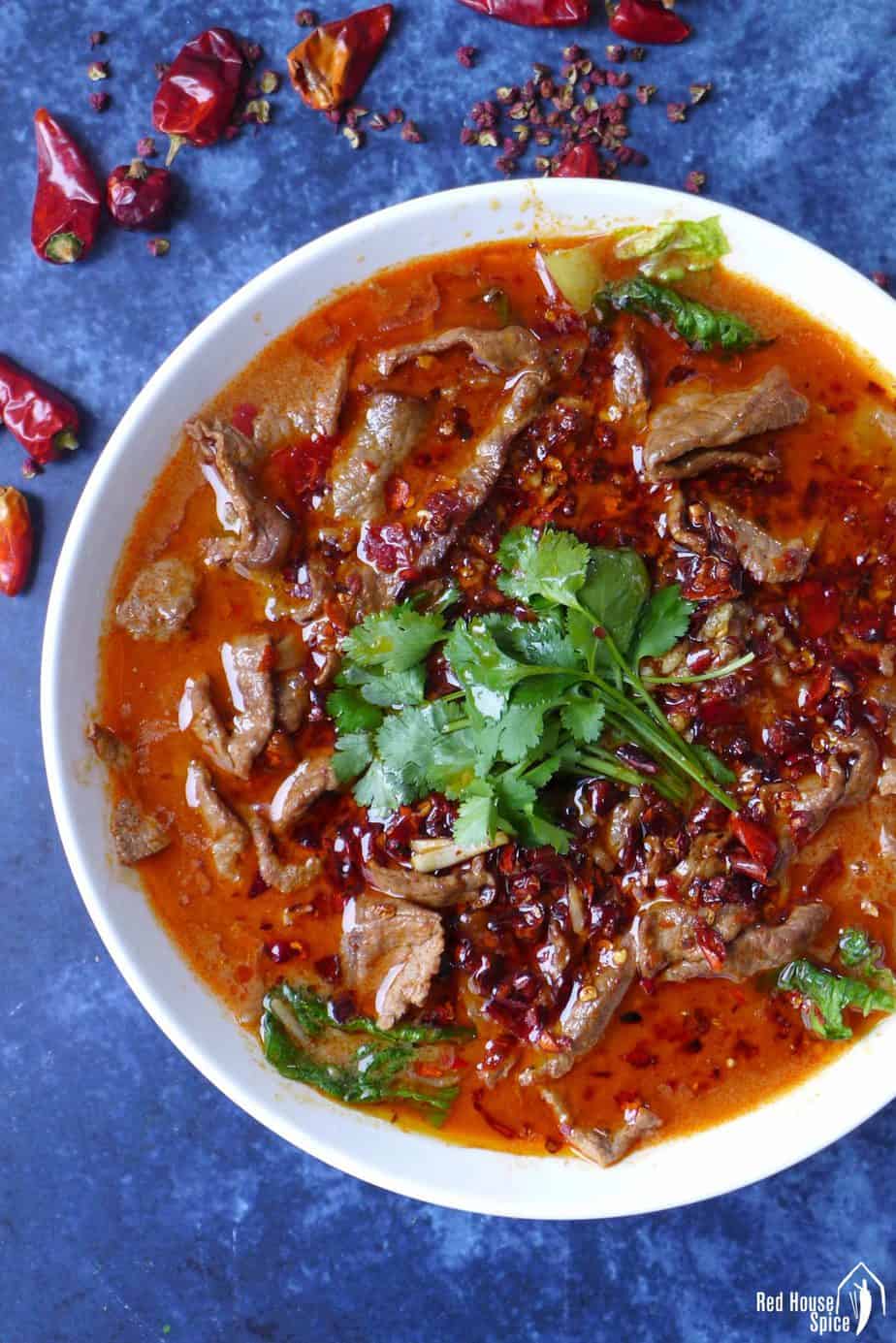 If you lot are a regular reader of my web log, you must have noticed my passion for Sichuan cuisine. Today'due south recipe Sichuan boiled beef (Shui Zhu Niu Rou/水煮牛肉) is another classic dish on my Sichuan listing. Information technology'south truly irresistible and so you must requite information technology a endeavour!
If you lot are a regular reader of my web log, you must have noticed my passion for Sichuan cuisine. Today'due south recipe Sichuan boiled beef (Shui Zhu Niu Rou/水煮牛肉) is another classic dish on my Sichuan listing. Information technology'south truly irresistible and so you must requite information technology a endeavour!
What does Sichuan boiled beef taste like
The Chinese name for this dish is "Shui Zhu Niu Rou/水煮牛肉", literally meaning water boiled beef. Sounds plainly and mild, right? In fact, it's super pungent and exciting. It's a sister dish of Sichuan Boiled Fish which is one of the most pop recipes on my blog.
Delicious beef slices and crispy vegetables are seasoned with generous amounts of dried chilli, Sichuan peppercorn, chilli bean paste, ginger, garlic, etc. Hot, numbing and aromatic, information technology creates a mini political party on your tastebuds!
6 steps to cook Sichuan boiled beef
Let's firstly talk most the workflow of cooking Sichuan boiled beefiness. The following six steps outline the methods and sequence required:
- Marinate the beef: Combine beef slices with rice wine, soy sauce, egg, cornstarch and water. Coat with a sparse layer of sesame oil.
- Fry the spicy topping: Fry dried chillies and Sichuan peppercorns with a trivial oil then chop pocket-sized.
- Fry the vegetables: Fry crispy vegetables until they lightly wilt.
- Prepare the goop: Fry ginger, garlic, Sichuan chilli bean paste and chilli powder until fragrant. Then pour in stock/water.
- Melt the beef: Add marinated beef piece past piece. Simmer until fully cooked. Add to the vegetables.
- Sizzle & garnish: Place garlic & chopped spicy topping over the beefiness. Cascade hot oil over. Garnish with coriander.
Please refer to my tutorial video (in the recipe carte beneath) to see how I cook it.
How to make the beef succulent
The virtually of import part of cooking Sichuan boiled beef is to make certain the beefiness is tender and succulent. Tough, chewy beef would ruin the enjoyment of the dish even if you lot've got the flavour right. Here are 4 tips to help you succeed:
i. Choose the correct cut of beef
Different cuts of beef accept quite different textures. Based on the availability and your budget, choosing the right cut of beef is the commencement decision y'all need to make.Tendre cuts with a little fat are preferable.
To be honest, I don't have much in-depth knowledge of beef cuts (still learning every day). But I establish some adept online resources on this matter. "The Consummate Guide to Beef Cuts" explains the standard cuts in the UK, whereas "Beef Cuts Explained: Your Ultimate Guide To Dissimilar Cuts of Beef" shows a list of American key cuts.
I use "Thick Rib" bought from British mainstream supermarket (I believe information technology's the equivalent of Cross-Rib Chunk in the U.s.a.). Information technology's an inexpensive cut, yet very flavourful and tender enough for this dish when marinated properly.
2. Slice the beef the right mode
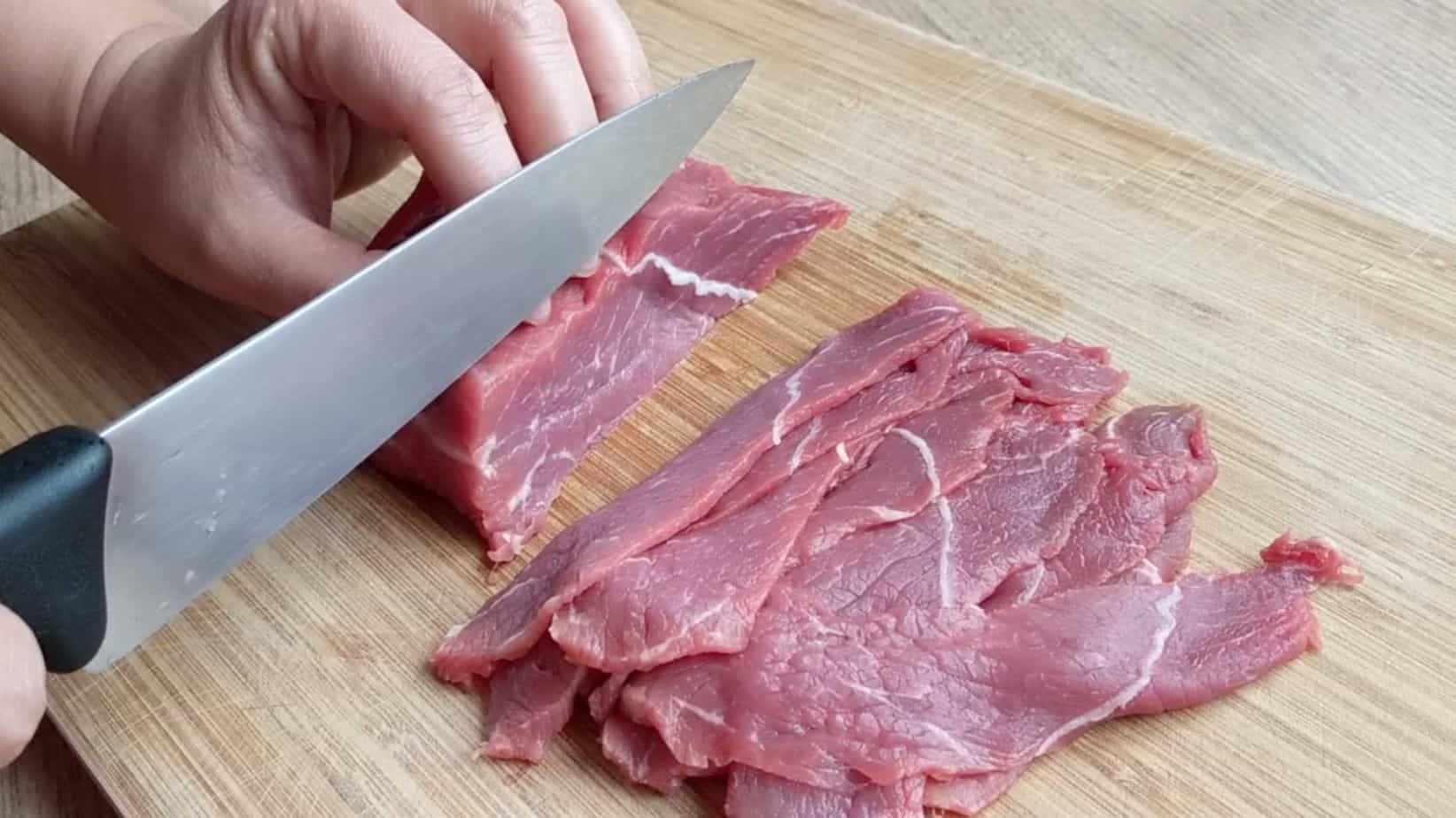
For Sichuan boiled beefiness, you need to cut the beef into sparse slices, ideally around 2mm in thickness.
- Acuminate your knife first. This helps a lot.
- Make sure you slice the meat against the grain for the all-time tenderness.
- If you notice it difficult to slice fresh beef, put it into the freezer until one-half frozen then cut.
3. Marinate to lock in the moisture
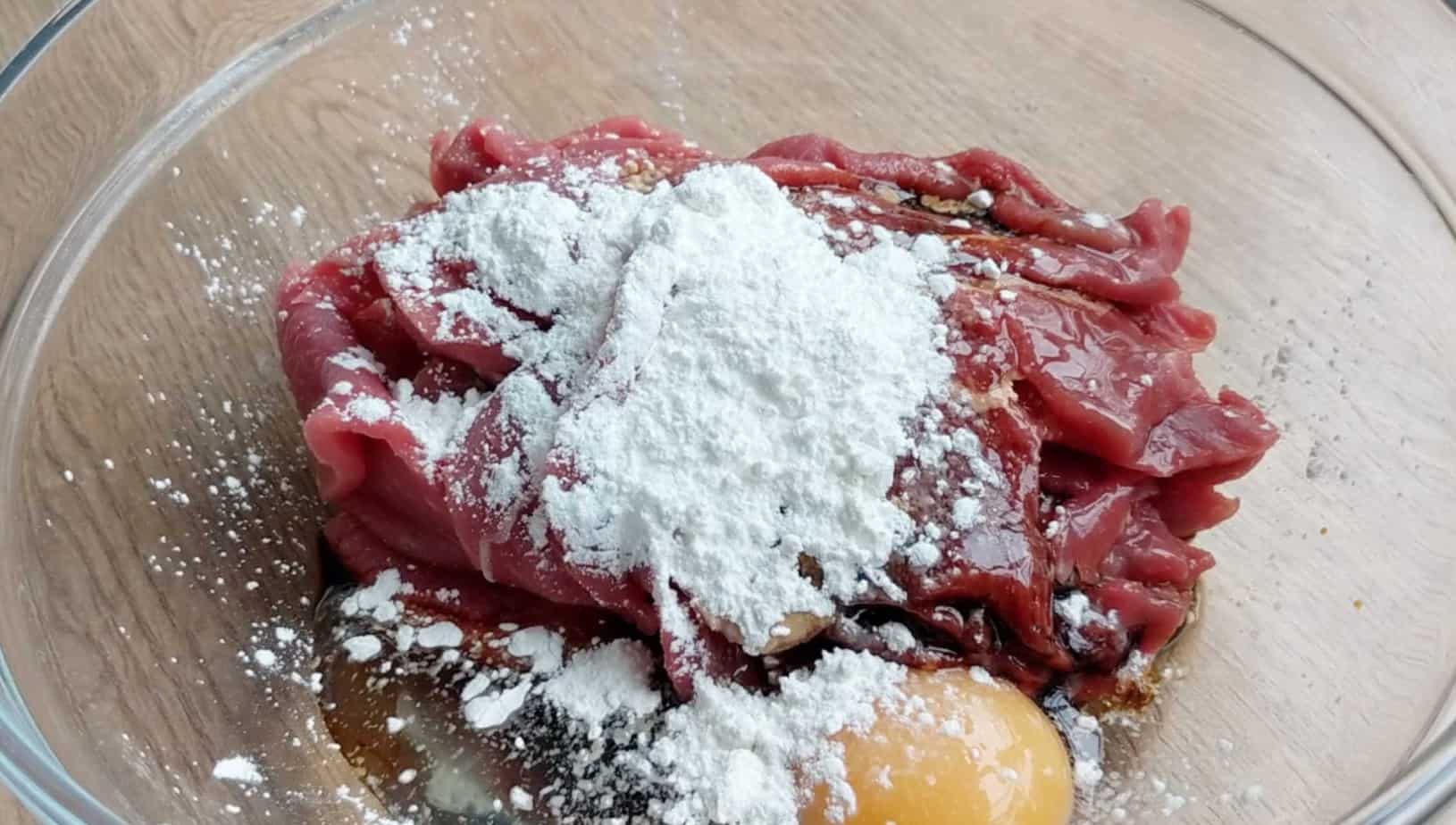
To marinate the beef slices, you would need to:
- Mix beefiness with salt, Shaoxing rice wine, nighttime soy sauce (or regular soy sauce), egg, cornstarch and h2o.
- Rub and stir with manus until all the liquid is absorbed.
- Drizzle a little sesame oil to separate the beef slices and to add extra flavour.
iv. Cook it for the correct time
As the name "Sichuan boiled beef" suggests, the beef slices are cooked in the goop instead of stir-frying. To avoid overcooking the beef thus making information technology tougher, yous should:
- Turn down the heat when you beginning putting the beefiness into the goop.
- Add beef piece by piece to avoid sticking.
- Simmer the beef, instead of violently humid.
- Remove from the estrus as soon every bit no pinkness can't be seen on the surfaces of the meat.
Make a delicious broth
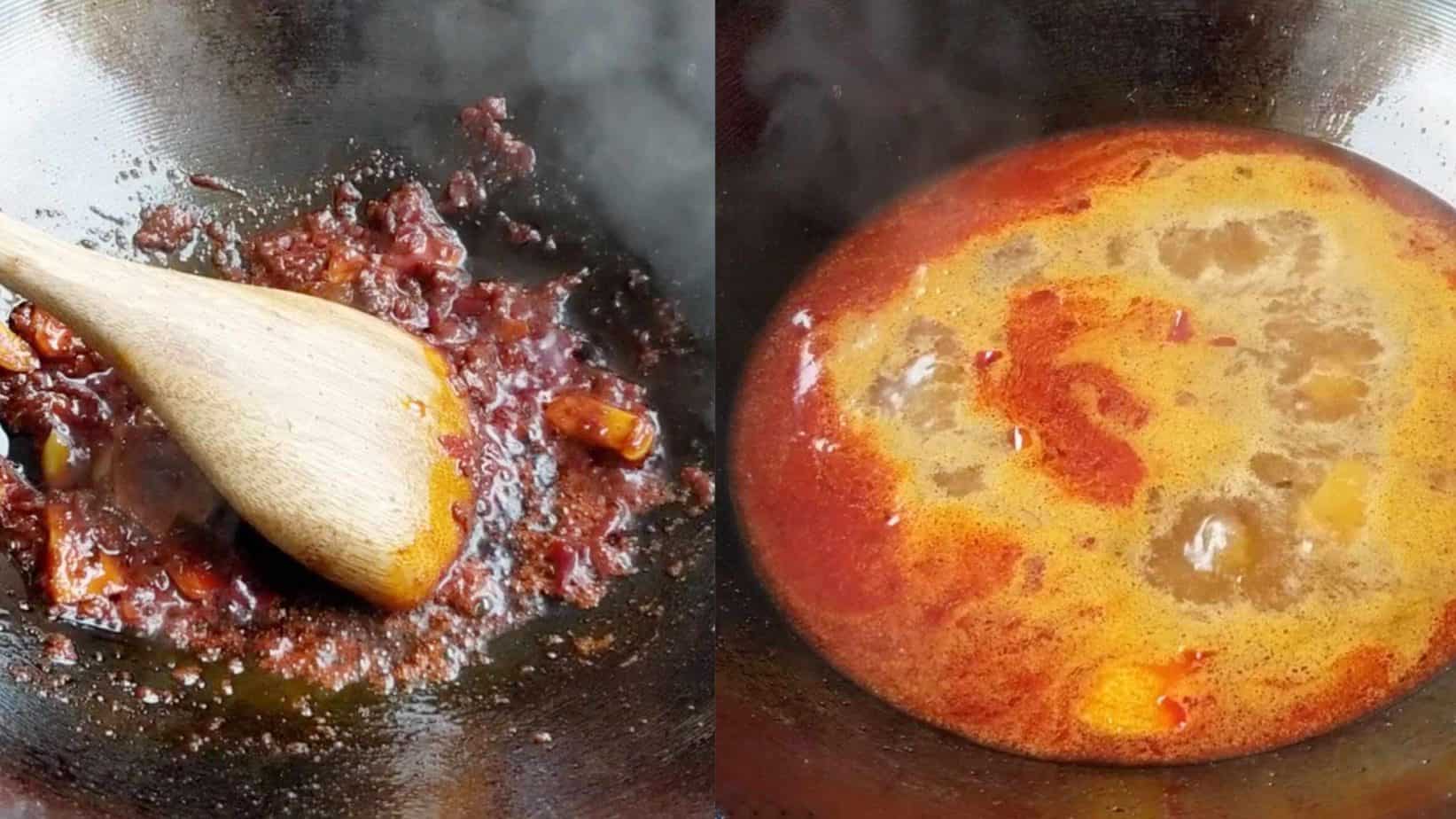
To make a delicious goop in which the beef slices are cooked, yous will demand:
- Cooking oil to fry the seasoning
- Sichuan chilli bean paste & chilli powder to spice upwards the goop
- Sliced ginger & garlic to add together flavour
- Unsalted stock or water
Sichuan chilli bean paste (Doubanjiang/豆瓣酱), aka broad bean paste, is the fundamental ingredients for the tasty broth. It'southward widely used in Sichuan cuisine and can exist purchased in Chinese stores/online shopping platforms. The all-time-known variety is Pixian Douban (郫县豆瓣, Pixian broad bean paste) which needs to be coarsely chopped prior to cooking.
Choose crispy vegetables
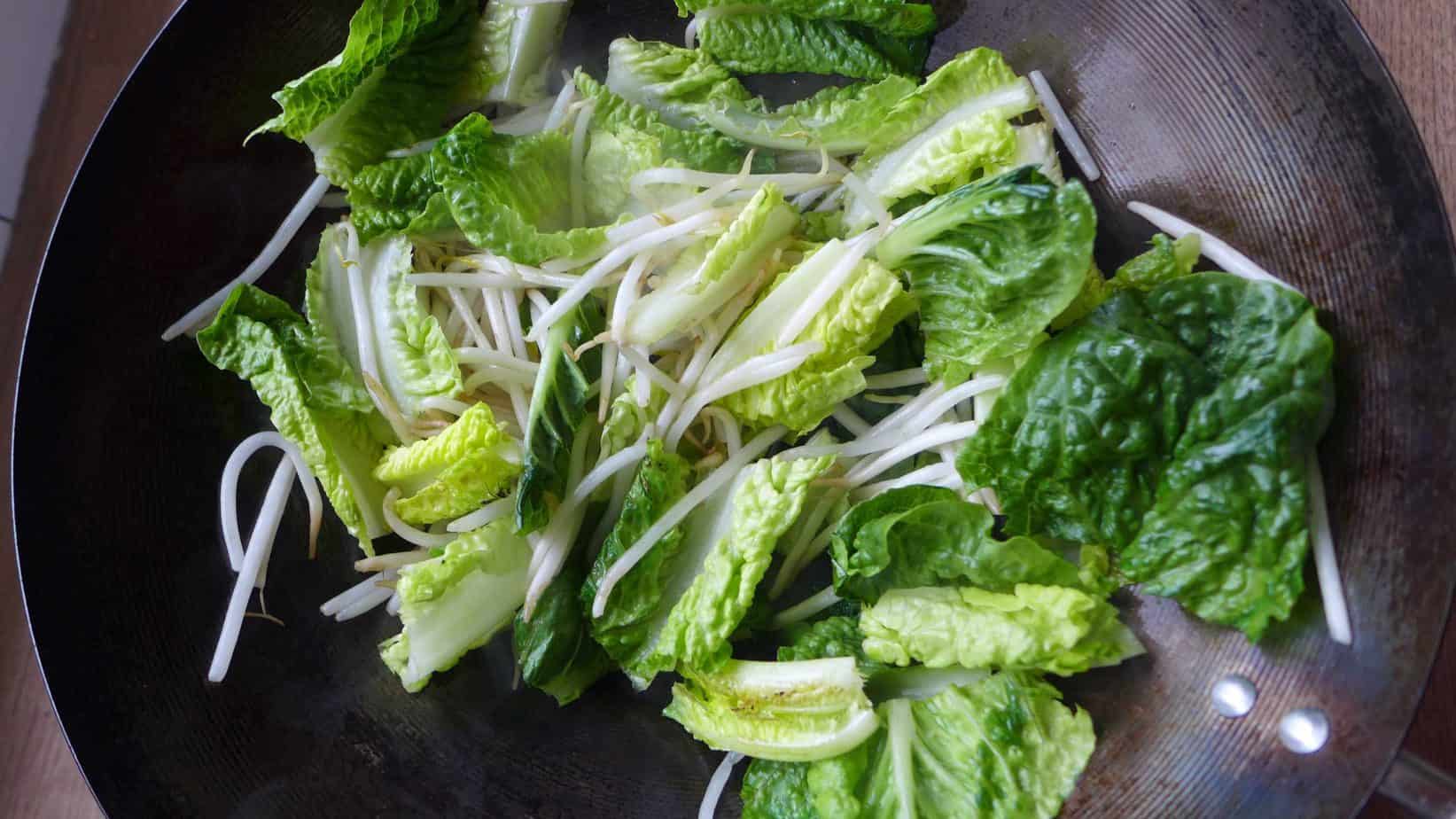
Sichuan boiled beef is not purely a meat dish. Underneath the beef, you always find some crispy vegetable. Bean sprouts (either mung bean sprouts or soybean sprouts), celery, lettuce, and Chinese cabbage are the popular choices. I use the combination of bean sprouts and romaine lettuce for this recipe. Please feel free to make your own selection.
Use good quality chilli & Sichuan pepper
What makes Sichuan boiled beef super addictive is the wonderful Málà (hot & numbing) sensation created by dried chillies and Sichuan peppercorns. Using those two spices with the all-time quality possible will make your dish stand out.
Mix different types of chillies
Good chillies should non but be hot only also aromatic. You may choose the variety that suits your level of tolerance to spiciness. Overly hot chillies tend to kill other flavours thus are not recommended.
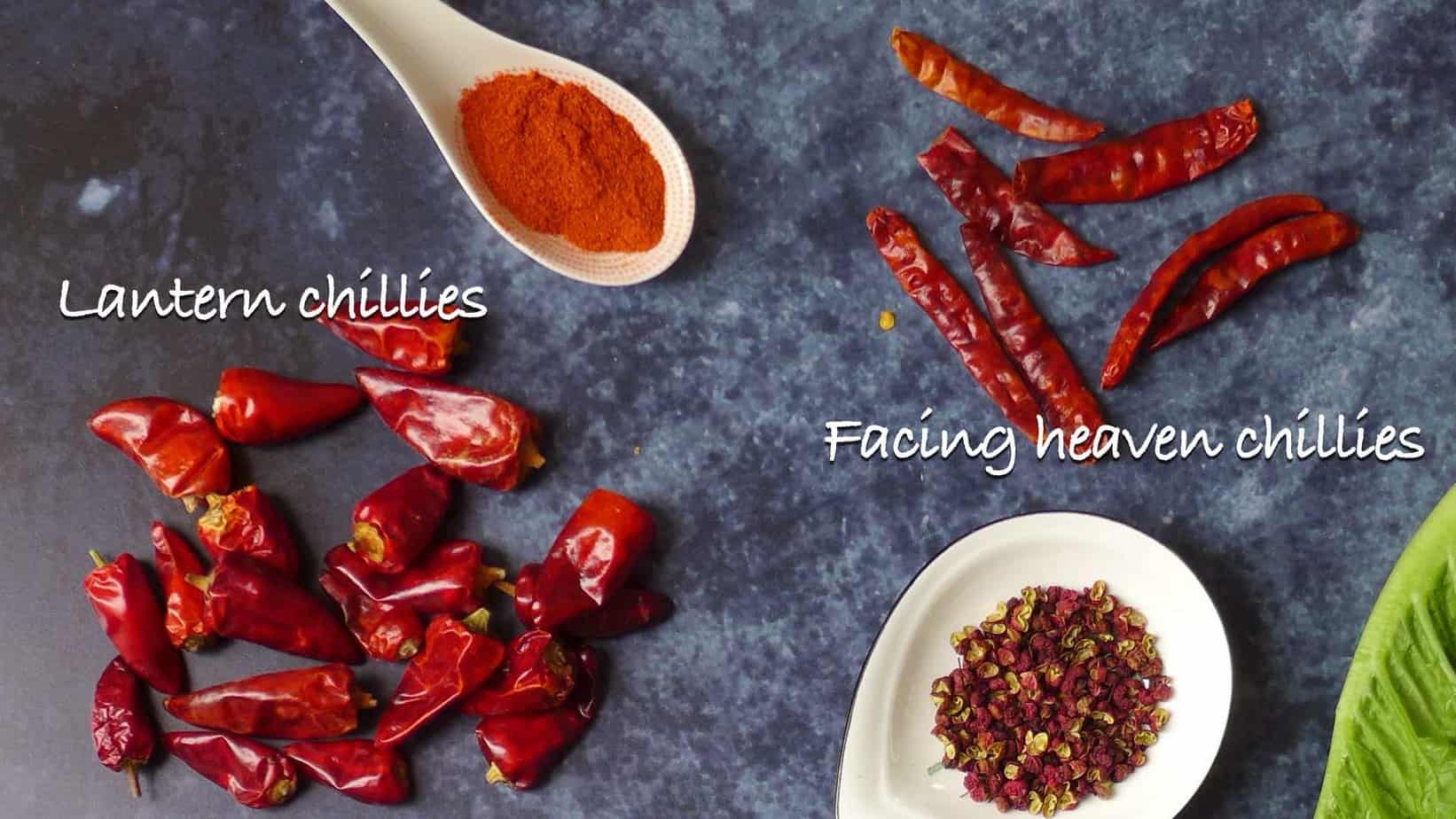
I mix 2 types of Chinese stale chillies to create a Xiāng Là (香辣, hot & fragrant) taste for this dish:
- Facing heaven chilli (Chao Tian Jiao/朝天椒). It'due south a variety of chilli unremarkably used in Sichuan cuisine. It's about 4-6 cm long and has a quite high heat level.
- Lantern chilli (Deng Long Jiao/灯笼椒). Information technology's named later its lantern-similar shape and is mild in heat but very fragrant.
The quality of Sichuan pepper matters
The numbing awareness and citrus olfactory property delivered by Sichuan pepper is disquisitional likewise. Equally my post "Sichuan pepper: your questions answered" explains, there isn't any substitute for this unique spice. Good quality Sichuan peppercorns will add a lot of excitement to the dish.
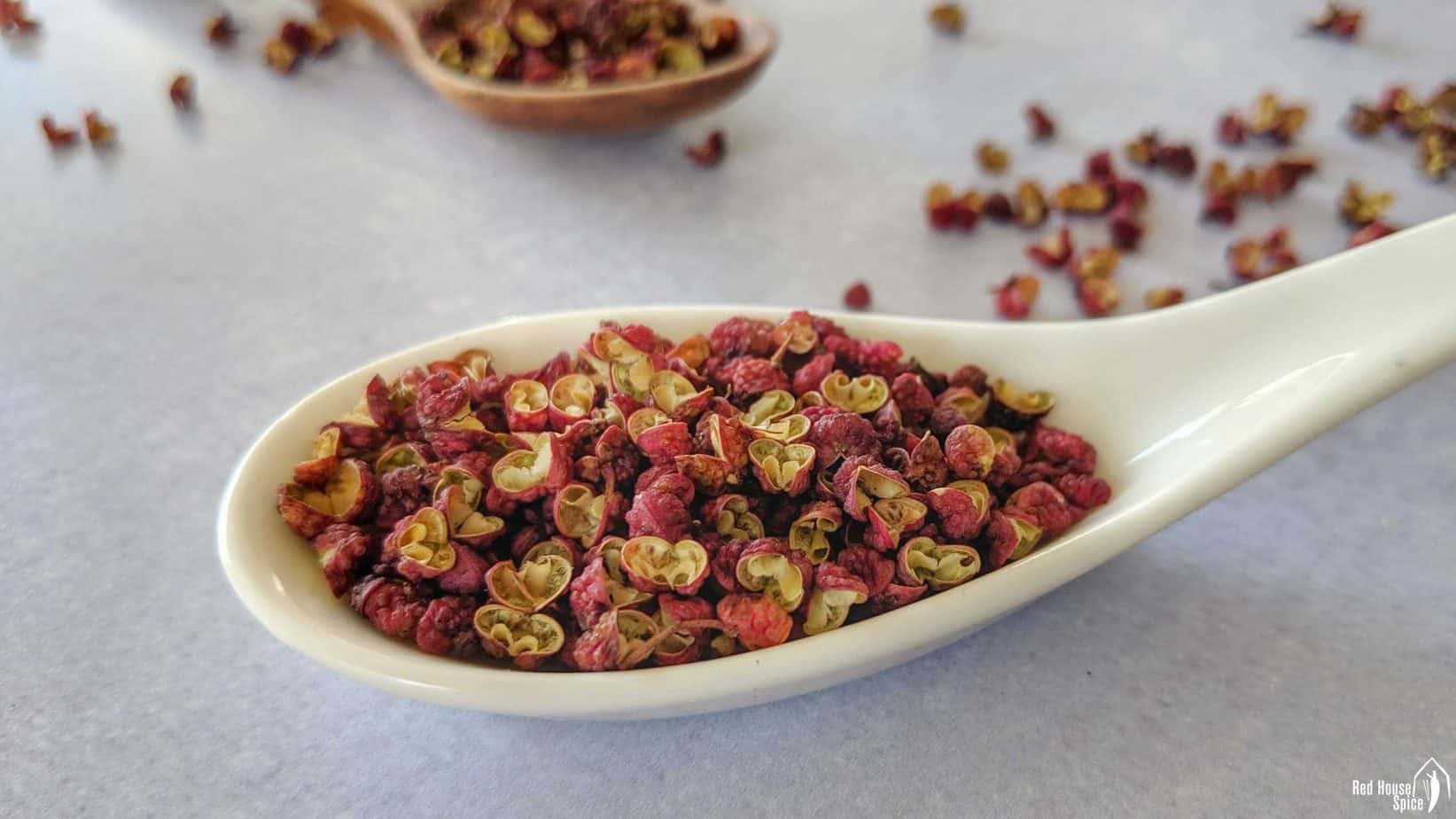
When buying, you demand to look out for the following traits:
- Look: They are fifty-fifty in size and bright in colour. Husks open with very few black seeds left inside.
- Aroma: They have a powerful, enticing odour. Rub a few peppercorns and then smell your fingertips. The smell should be very noticeable.
- Taste: Chew ane peppercorn. The tingling, numbing awareness should exist strong and linger for several minutes in your mouth. No strange bitterness though.
Also, please feel gratis to use either regular red Sichuan peppercorns or the green diversity. Or, use the mixture of both.
Two steps to bring out their all-time flavour
Heat brings out the best aroma and flavor of chilli and Sichuan pepper. Follow two steps to attain this:
i. Fry stale chillies and Sichuan peppercorns in a little oil over low heat until fragrant. Watch attentively to make sure you don't burn them.
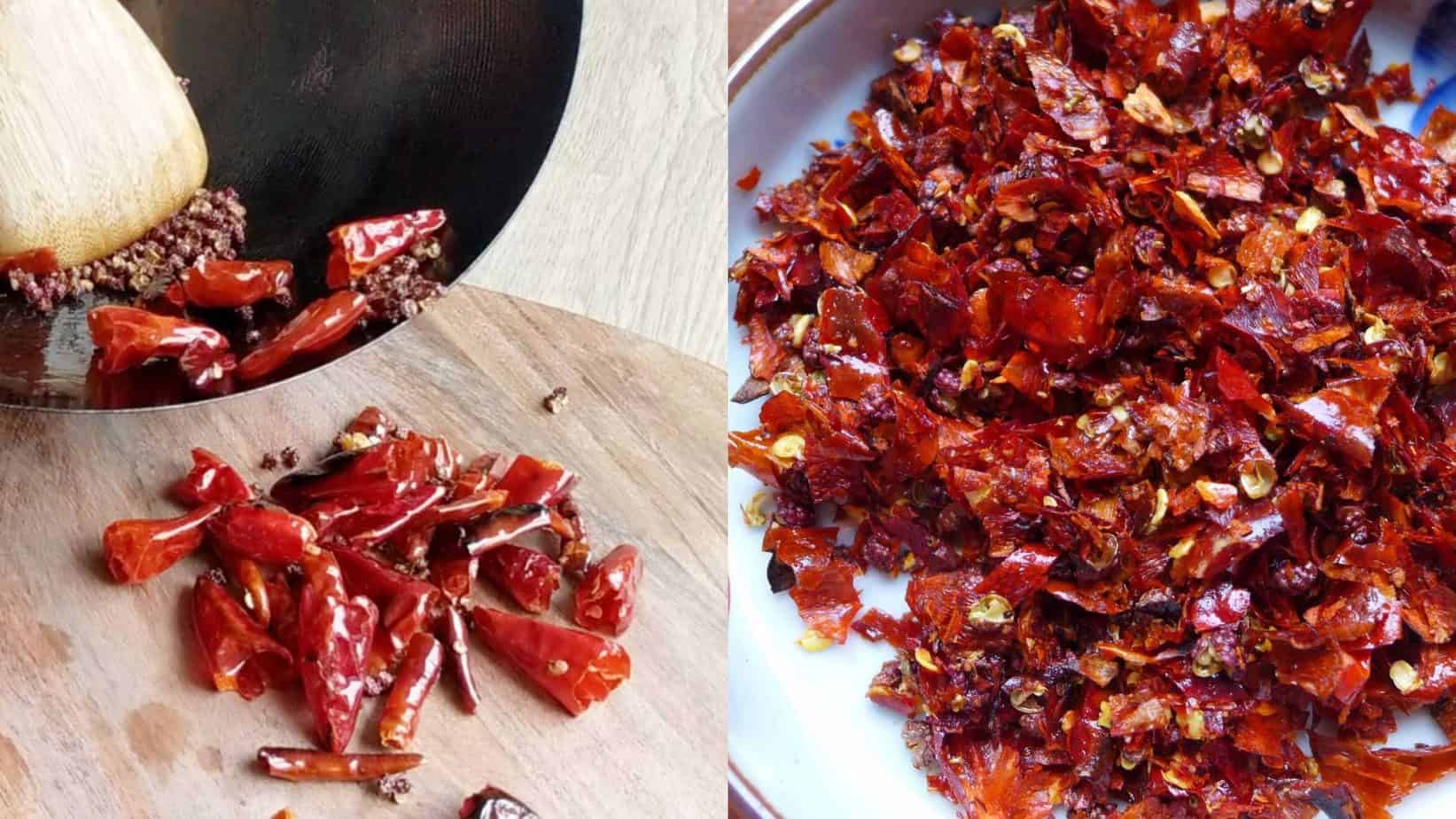
ii. Chop the spices small then place onto the cooked beef. Pour hot oil over to sizzle. This last procedure really enhances the "Málà" taste of the dish.
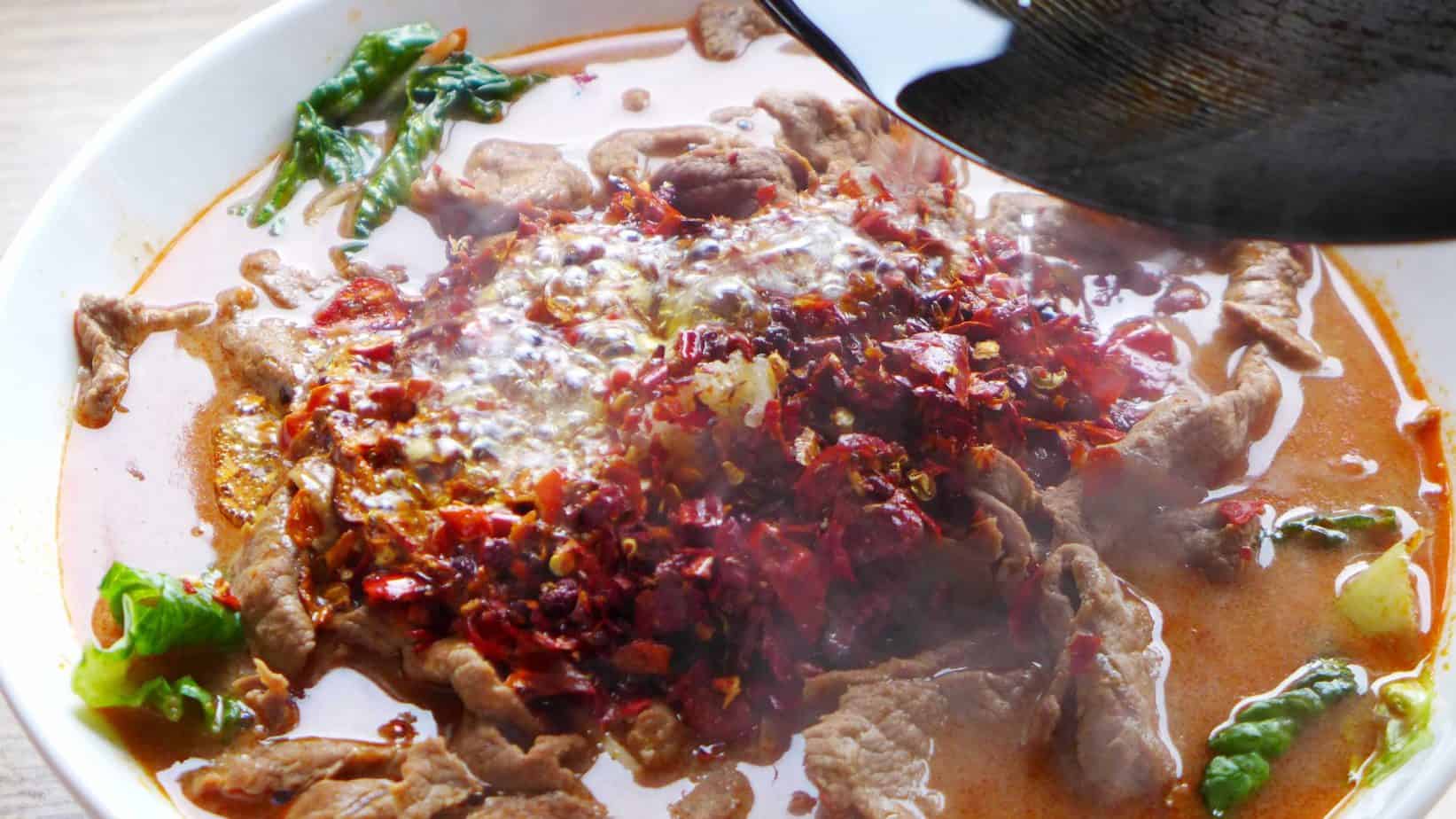
Looking for more spicy dishes? Check out my other recipes, such as:
- Mala chicken (La Zi Ji, 辣子鸡)
- Mapo tofu (麻婆豆腐)
- Hunan Beefiness Stir-Fry (小炒黄牛肉)
- Chinese Hot Pot (火锅)
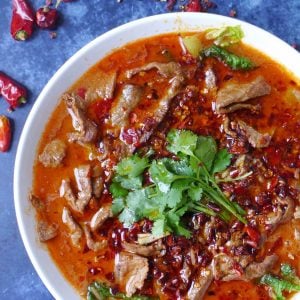
For the beefiness
- 300 g beef, 10oz, see note one
- 1 pinch salt
- ane teaspoon Shaoxing rice wine
- 1 teaspoon dark soy sauce, or regular soy sauce
- 1 egg
- i tablespoon cornstarch
- 2 tablespoon water
- 1 teaspoon sesame oil
For the spicy topping
- 1 teaspoon cooking oil
- 1 handful stale chillies, seeds removed, see note 2
- one tablespoon Sichuan peppercorns, run into note 3
For the vegetables
- half Romaine lettuce, coarsely chopped
- i handful bean sprouts
For the broth
- 2 tablespoon cooking oil
- half-dozen slices ginger
- 3 cloves garlic, sliced
- 2 tablespoon Sichuan chilli bean paste, see note 4
- 1 teaspoon chilli powder, or to gustation
- 500 ml unsalted stock or h2o, ii cups
For the garnish
- 2 tablespoon cooking oil
- 1 tablespoon minced garlic
- coriander, chopped
Marinate the beef
-
Cut the beef, confronting the grain, into sparse slices (most 2mm).
-
Put them into a mixing bowl. Add salt, Shaoxing rice wine, dark soy sauce, egg, cornstarch and h2o.
-
Rub and mix with hands until the liquid is absorbed.
-
Add together sesame oil so stir well.
Fry the spicy topping
-
Add oil, dried chillies and Sichuan peppercorns in a wok.
-
Fry over low heat until fragrant (practise not burn).
-
Transfer onto a chopping lath. Chop small then set aside.
Fry the vegetables
-
Put romaine lettuce and bean sprouts in the same wok.
-
Fry with the remaining oil over medium estrus until they lightly wilt.
-
Transfer to the serving basin and set bated.
Set the broth
-
Pour oil into the wok. Add together ginger, garlic, Sichuan chilli bean paste and chilli powder. Fry over low heat until fragrant.
-
Pour in stock/h2o. Melt over loftier estrus until it starts humid.
Cook the beef
-
Turn the rut to medium. Add together marinated beef, one piece at a time.
-
Simmer until fully cooked (no pinkness on the surface).
-
Pour the beefiness and stock onto the vegetables.
Sizzle & garnish
-
Place minced garlic & chopped spicy topping over the beefiness.
-
Rut up the oil in the wok (cleaned and dried) until smoking. Pour it over the garlic & spices.
-
Garnish with coriander and serve immediately with plain rice.
1. You may use any cuts of beefiness (except for some tough cuts for stewing dishes). I quite like thick rib which is an inexpensive cutting, nonetheless very flavourful and tender enough for this dish (when marinated properly).
2. Cull dried chillies that arrange your level of tolerance to spiciness. I use two types of Chinese dried chillies for this dish:
- Facing sky chilli (Chao Tian Jiao/朝天椒) which has a quite high estrus level.
- Lantern chilli (Deng Long Jiao/灯笼椒) which is mild in heat but very fragrant.
3. You may use regular red Sichuan peppercorns or the light-green diversity. Delight refer to my post "Sichuan pepper: your questions answered" to acquire more than nearly this unique Chinese spice.
4. Sichuan chilli bean paste (Doubanjiang/豆瓣酱, aka spicy broad edible bean paste) is widely used in Sichuan cuisine and can be purchased in most Chinese stores. The best-known variety is Pixian Douban (郫县豆瓣) which needs to be coarsely chopped prior to cooking.
Serving: i serving | Calories: 410 kcal
Prove me your dish or ask me questions @red.house.spice
Reader Interactions
Source: https://redhousespice.com/sichuan-boiled-beef/
